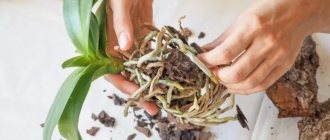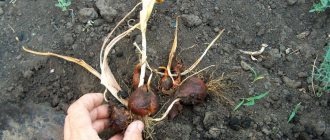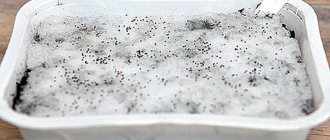When do the seeds ripen?
Primrose can be propagated not only by dividing the bush and cuttings, but also grown from seeds, which are collected from the testes that appear after flowering and immediately placed in the soil. Usually this process occurs at the end of September, beginning of October, it is at this time that the seeds fully ripen.
Recommendation. You should not leave the seeds for next year, as their germination rate will be significantly reduced.
Necessary steps to prepare the plant for winter
Before the snow falls, it is necessary to timely prepare the primrose for winter. It is worth noting that many varieties of garden primroses are resistant to frost and do not need special shelter , but there are hybrid plants, it is advisable to dig them up and place them indoors in special storage containers.
As for frost-resistant varieties, they need to be prepared for wintering:
to protect the roots from frost, humus is added under the bushes of the plant in late autumn;- It is worth noting that for frost-resistant flowers, a shelter from a thick layer of snow is sufficient, but not every winter is snowy and this must be foreseen in advance, so it is better to cover the primrose with spruce branches as soon as frosts begin to reach -10 degrees;
- Do not touch the foliage of the plant, it serves as protection; it is better to carry out these actions in the spring.
Soil and fertilizers
What to feed? Primrose loves fertile, light soil , and if the soil on the site is clayey, then you need to add to it (calculation per 1 square meter):
- river sand – 3 buckets;
- humus - 0.5 buckets;
- superphosphate – 40 g;
If the soils are sandy, then they can freeze in winter, so they add (calculation per 1 m2):
- humus - 2-3 buckets;
- potassium and phosphorus – 20-30 g;
- clay - 0.25 buckets.
Features of planting a perennial plant
It is worth remembering that to decorate the site you need to plant the plant correctly; how to do this is the answer below.
Reference. The distance between small bushes should be at least 25 cm, and for large plants - 45 cm, otherwise, as the bushes grow, they will interfere with each other.
You can plant primrose in different ways, but let’s look at when to do it and how to do it using the most common methods.
Seeds
Most gardeners prefer to propagate the plant by seeds. Sowing can be done 3 times per season.
Gardeners generally prefer to plant primrose in this way. The nuance is that it differs in technology, since this can be done 3 times per season, while the sowing technology differs:
- Planting in spring. It is worth remembering that primrose seeds lose their viability very quickly, so for spring planting in the garden you need to use seeds purchased in the store.
But before planting the plant in open ground, you need to prepare the seeds. A month before planting, you need to pour a special soil mixture into a container and scatter the seeds over it. You don’t need to sprinkle them, just press them a little into the soil. Not all varieties of primrose need stratification, so before you start preparing seeds for sowing, you should clarify whether it is worth applying long-term preparation to a particular variety. - Sowing in autumn is the most popular technology among gardeners.
If you use this planting method, the plants will delight you with flowers for the next season. The only rule when planting in the fall is to cover the soil in which the seeds are sown to prevent freezing. Interesting! As soon as the snow begins to melt and the plant will be provided with a sufficient amount of moisture, which is very good for young sprouts. At the same time, in early spring there are no burning rays of the sun that can harm young leaves. - Sowing seedlings at home at the end of January, beginning of February. This method is more labor-intensive, as it requires careful preparation of the seed, so it is used only in exceptional cases.
It is worth noting that if it is not possible to sow primrose yourself, you can buy ready-made seedlings and propagate plants using simpler methods.
From the video you will learn how to plant primrose seeds:
Cuttings into the ground
This method of propagating a plant is very simple; let’s look at how to plant a cutting correctly:
Carefully separate the part of the shoot at the neck of the root so that there is a bud and a leaf on it. In this case, the sheet plate must be cut in half.
- Prepare the soil by mixing sand and humus in equal quantities.
- Plant the cuttings in the prepared composition.
- For rooting, you need to create optimal conditions for the plant:
- temperature – +17 degrees;
- bright lighting without direct sunlight;
- the soil is moderately moist.
When the third leaf appears, the primrose is transplanted into a small pot, the diameter of which should not be more than 10 cm. The plant is planted in the garden with the onset of warm weather in an open area.
From the video you will learn how to divide primroses in the fall:
Primrose transplant
Primrose needs to be replanted once every three or four years. There are several reasons for this:
- Perennial varieties grow over this period of time and the rosettes become cramped in the allotted area.
- The splendor and duration of flowering are reduced.
- The root system is exposed, which can die in winter from the cold.
The situation can be corrected by replanting the primrose, dividing the mother plant into several young bushes. In this way, you can combine transplanting and propagating primrose in the garden.
It is best to carry out the procedure immediately after the end of flowering; each type of primrose has its own specific period of the year. Before the winter cold, young plants will have time to take root and grow stronger.
If for some reason it was not possible to replant the primrose, you can divide the bushes in the fall, but in this case, peat, humus or good hilling must be poured under each young plant.
During the planting process, you need to add manure, ash and sand to the planting holes. The distance between bushes of large primroses is at least 40 cm, and low-growing, miniature varieties can be planted at a distance of 10-15 cm. However, if you want to quickly get a decorative effect from primrose, the bushes should be planted as close to each other as possible.
It is important to remember that it is better to carry out all work in the garden in cloudy weather and keep the soil well moistened.
When is it better to replant: in spring or autumn?
When to replant the plant? Transplanting a flower to another place can be done both in autumn and spring; there is not much difference when growing a flower in the southern regions.
Important! In central Russia, replanting needs to be done only in the spring, otherwise the roots simply will not be able to gain strength before the winter cold, and the primrose may not survive the winter.
Possible diseases and treatment
Primrose is a plant that is very resistant to various pests and infections. But she is very vulnerable during the transplant and post-transplant period. During this period, the plant may be subject to the following attacks:
- anthracnose;
- powdery mildew;
- rust;
- rot.
In addition, primrose may experience fungal infections:
- Cercosporella;
- ramularia;
- bacterial spot.
Diseases affect both young leaves and old ones. The fact is that during the rooting period after transplantation, the plant’s immunity is greatly weakened, and it cannot cope with diseases and pests on its own - the primrose needs to be helped by treating it with fungicides.
You can spray the plant with copper oxychloride or Bordeaux mixture. You should also not forget that late blight, a parasitic fungus that can kill the plant, may appear on the crop - in this situation, reduce watering. Slugs, aphids, weevils, nematodes, mites and flea beetles can also greatly annoy young plants, so treatment with such drugs as:
- Intavir.
- Spark.
- Ragor.
Primrose blossom
The main criterion for classifying primroses is their flowering period.
Second half of April – first half of May
During this period, the spring primrose is the first to bloom. The wrinkled leaves form a basal rosette, from the center of which a peduncle up to 30 cm high appears, topped with an umbrella-type inflorescence. The flowers are predominantly simple yellow, but hybrid varieties come with double flowers in a variety of shades.
Around the same period of the year, the common primrose blooms. The peduncles are short, with inflorescences located at the end of each. There are many flowers, thanks to this a bright cushion up to 12 cm high is formed. The flowers are large - up to 3 cm in diameter, in a wide variety of shades.
The most popular varieties:
- Virginia;
- Cerulea.
Another early-flowering species of primrose is tall. Peduncles reach a height of 20 cm, on each of which several inflorescences bloom at once.
The most popular varieties are:
- Alba;
- Aurea;
- Goldrand;
- Gartenprimel.
Primrose multiflora belongs to the same species and flowering period, the peduncle of which reaches a height of 40 cm and is capable of forming up to 20 flowers.
Mid May
The most popular primrose of this flowering period is the fine-toothed primrose. The plant received its name due to the shape of the leaves - the edges of the leaf blade are jagged. The peduncles are tall - up to 40 cm, and by the time flowering ends, their length reaches 60 cm. The inflorescences have the shape of a ball, formed by many small flowers of different shades.
Also worth noting is the low-growing primrose Julia, which blooms with crimson flowers, its hybrid - the primrose Romeo and Juliet - blooms with pink and blue inflorescences. During the flowering period, primrose forms a continuous bright carpet, which is why it is often grown on alpine hills. In addition, Julia's primrose is the most frost-resistant variety.
A little later, the auricular primrose blooms. The plant is distinguished by dense leaves, with a smooth structure and an unusual green color with a blue tint. The edges of the leaf plate are rolled inward. The flowers are quite large - up to 4 cm in diameter, collected in umbrella-type inflorescences of 10 pieces. Hybrid variety of primrose - pubescent.
The end of May
During this period, Siebold's primrose blooms. This is a low-growing plant with light green leaves and pink flowers with a white center.
At the end of the flowering period, the ground part dries out completely, so as not to damage the root system, it is necessary to mark the planting site of the bush.
Mid summer
This is the flowering period of a rare group of primroses - Candelabra. The homeland of these plants is Japan. This type of primrose is distinguished by a high peduncle - up to 50 cm, the flowers are arranged in several tiers and are colored purple. Primrose Bisa, Bullya and the Bulleziana variety belong to this group.
End of summer
Primrose Florinda is the last flower of the season to bloom. The birthplace of the flower is Tibet, which is why it is quite difficult to find it in gardens. The peduncle reaches a height of 80 cm, growing from the center of the rosette of leaves. The flowers are bell-shaped and bright orange. This primrose can be planted near a pond.
Care
Top dressing
On a note. Primrose is called a primrose and this is no coincidence, since it begins to grow when the snow melts. Therefore, it needs feeding in early spring.
Complex fertilizers are applied to the soil, which should contain (per 1 square meter 10-20 grams):
- phosphorus;
- nitrogen;
- potassium.
In addition, it is worth removing dried leaves, which will interfere with the application of fertilizers, and the soil under the bushes must be well loosened so that there is air access to the roots.
Repeated feeding is carried out 12-15 days after the primrose blooms. Organic fertilizer is used, which is diluted in proportions of 1:10, 0.5 liters of solution is poured under one flower. This will help the plant set flower buds for next year.
Trimming
Pruning is a necessary and important procedure that is not recommended to be neglected. Should the plant be pruned in the fall? This procedure must be done at a certain time, and it is better in the spring, as soon as the snow melts and the severe frosts stop. This will stimulate the plant to grow and bloom again.
We talked in detail about caring for primrose outdoors and at home here.
How can I plant?
Sowing seeds
They grow so intensively that they can even displace other inhabitants from the flowerbed. You can sow such seeds in the fall, having previously prepared the soil according to all the rules so that it is sufficiently light, loose and nutritious.
Read also Happy birthday flowers in pictures for a girl
The soil for seedlings is suitable from loose deciduous soil mixed with sand in a ratio of two to one. Primrose seeds are not buried, but only slightly sprinkled with a layer of soil . The second option, which is also more effective, is to wait for the spring shoots from self-seeding and transplant the seedlings that have gained strength.
Other types of primroses for propagation from seed material must be sown in winter so that by spring the seedlings are ready for planting in the ground. This is a more labor-intensive and lengthy process. Over time, primrose seeds tend to lose their viability, so autumn sowing is, to some extent, more optimal, if you do not take into account some varietal characteristics.
Watch a video about growing primrose from seeds:
You will find even more useful information about growing primrose from seeds and subsequent care for it here.
Cuttings into the ground (axillary shoots)
If the roots are weak or the rosette is singular, then this method will be just right:
The leaf is separated with a fragment of the petiole, a bud and part of the shoot.
- The leaf plate is shortened by half.
- Next, rooting is carried out in the substrate.
Rooting of primrose cuttings occurs at a temperature of 16-18 degrees . Therefore, you will need a mini-greenhouse for cold nights and days. If a shoot with three or four leaves appears from the bud, this means that the plant has taken root and taken root.
Pinching the top bud in advance will encourage the primrose to activate the vital potential of the lateral buds and it will create many cuttings.
We discussed the features and timing of planting primrose in more detail in a separate article.











